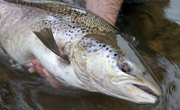
Bowfin are ancient fish, related to freshwater fish that were contemporaries of the dinosaurs. Often thought of as "trash fish" by anglers seeking more prized game fish, such as walleye or northern pike, bowfin are voracious predators, and they fight hard when you hook them. Because they are not particular about what they eat, you can catch bowfin on live or dead natural bait, or with a range of artificial lures.
Description
Found in slow-moving waters of lakes and rivers, bowfin can survive in murky, low oxygen environments because of their ability to gulp air from the surface, using the swim bladder as a rudimentary lung. Bowfin inhabit the eastern portion of the United States, from the Mississippi River and Texas to the East Coast, and from the St. Lawrence River and Minnesota to Florida.
Feeding Habits
Bowfin are aggressive, predatory fish that feed on aquatic animals. Their diet focuses primarily on bait fish, although they are opportunistic feeders, and will take anything alive that they can handle. This includes, crustaceans, amphibians, insect larvae and worms. A major concern on the part of fishermen is that bowfin often prefer to feed on juvenile game fish, which can significantly deplete the total population of game fish in a given area.
Natural Baits
To catch bowfin, bait fish, including shad, minnows, suckerfish, shiners and small bream, fished live or as cut bait, work well. Bowfin also prefer crawfish, and can take frogs, salamanders and other aquatic animals. The In-Fisherman website recommends natural bait rigs similar to those used for catfish when you target bowfin.
Artificial Baits
According to Roughfish.com, most artificial baits that work for bass fishing will also attract a strike from bowfin. These include spinner bait, crank bait, spinners, spoons and soft plastics, such as worms or crawfish designs. You can even take bowfin by fly fishing. Try large streamers, crawfish patterns, woolybuggers or any other large fly that also works for bass. Do not be surprised if a bowfin destroys your lure when you are landing the fish.
Bait Presentation
Use a stout, medium-weight bait casting or spinning rod between 7 feet and 8 feet with 8 lb. to 10 lb. test line for fishing bowfin. These fish fight hard, so use a substantial line of heavy duty fluorocarbon or braided line. Roughfish.com suggests wire leaders, since bowfin have strong jaws and sharp teeth that can easily cut through monofilament or braided line.
To use live bait fish, hook the tail or lips, and let the fish swim on its own. To present other natural bait with a bottom rig, slide a small egg weight on the main fishing line and tie a swivel, leader and baited hook onto the end of the line. You can also work natural bait on a drift rig. Place a bobber on the main line, and tie a swivel, leader and baited hook to the end. Adjust the bobber so the bait is just off the bottom. Work artificial lures as you would for bass. Crank them past weed beds, fallen trees and other structures.
References
Writer Bio
In Jacksonville, Fla., Frank Whittemore is a content strategist with over a decade of experience as a hospital corpsman in the U.S. Navy and a licensed paramedic. He has over 15 years experience writing for several Fortune 500 companies. Whittemore writes on topics in medicine, nature, science, technology, the arts, cuisine, travel and sports.



